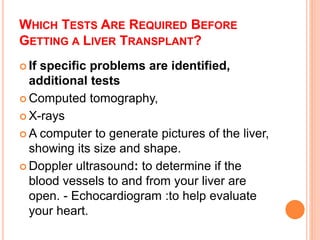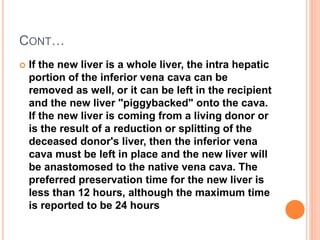Liver transplantation
- 3. LIVER ANATOMY The liver is located in the right upper portion of the abdominal cavity, just beneath the diaphragm, and is protected by the rib cage. It sits on top of the stomach, right kidney, and intestines. It is supplied with blood by the portal vein, which drains the splenic, intestinal, and colonic areas and is a rich source of nutrients and substances absorbed from the gut.
- 5. INDICATIONS FOR PEDIATRIC LIVER TRANSPLANTATION Crigler-Najjar syndrome Glycogenosis Hyperoxaluria Metabolic respiratory chain deficiencies Familial hypercholesterolemia Methylmalonyl aciduria Hepatitis C Cholestatic Metabolic Malignancy Other
- 6. CONT..
- 7. LIVER TRANSPLANT SYMPTOMS People who have liver disease may have many of the following problems: - Jaundice - Yellowing of the skin or eyes - Itching , tea-colored urine - Gray- or clay-colored blood movements - Ascites - An abnormal buildup of fluid in the abdomen - Vomiting of blood - Tendency to bleed - Mental confusion, forgetfulness
- 8. CONTRAINDICATIONS TO PEDIATRIC LIVER TRANSPLANTATION Transplantation is not indicated if an acceptable alternative is available or if contraindications, such as malignancy, a terminal condition, or poor expected outcome exist
- 9. . Alternatives to liver transplantation Alternatives to liver transplantation that are currently being researched include liver support devices, artificial organ construction, and hepatocyte transplantation. Waiting period Once a pediatric patient is found to be a suitable candidate for a liver transplant, the patient's name is placed on a waiting list for an organ. Unfortunately, many more potential recipients are on the waiting list than there are organs available each year.
- 10. PREPARATION Where Does a Liver for a Transplant Come From? There are two types of liver transplantation options: living donor transplantation and cadaveric transplantation. 1.Living donor - Living donor liver transplants are an option for some patients with end-stage liver disease. This involves removing a segment of liver from a healthy living donor and implanting it into a recipient. The donor, who may be a blood relative, spouse or friend, will have extensive medical and psychological evaluations to ensure the lowest possible risk. Blood type and body size are critical factors in determining who is an appropriate donor. - Recipients for the living donor transplantation must be active on the transplant waiting list.
- 11. WHERE DOES A LIVER FOR A TRANSPLANT COME FROM? 2.Cadaver In cadaveric liver transplantation, the donor may be a victim of an accident or head injury. The donors heart is still beating, but the brain has stopped functioning. Such a person is considered legally dead, because his or her brain has permanently and irreversibly stopped working.
- 12. WHICH TESTS ARE REQUIRED BEFORE GETTING A LIVER TRANSPLANT? If specific problems are identified, additional tests Computed tomography, X-rays A computer to generate pictures of the liver, showing its size and shape. Doppler ultrasound: to determine if the blood vessels to and from your liver are open. - Echocardiogram :to help evaluate your heart.
- 13. CONT… Pulmonary function studies to determine your lungs' ability to exchange oxygen and carbon dioxide. Blood tests to determine blood type, clotting ability, and biochemical status of blood and to gauge liver function. AIDS testing and hepatitis screening
- 14. ANESTHESIA IN PEDIATRIC LIVER TRANSPLANTATION Living donors receive general anesthesia and immediate transplantation of a portion of their liver into the recipient. Therefore, the patient receiving the transplant is prepared for surgery within the same time frame as the donor.
- 15. CONT… A liver from a deceased donor must be transplanted into the recipient within 12-18 hours. anesthesiologists performs an operation to remove the liver from the donor. The liver is then preserved and packed for transport
- 16. TECHNIQUE Most liver transplants are orthotopically performed, meaning the new liver is placed in the same location as the diseased liver. This requires that the diseased liver be removed. This portion of the operation is critical and can take several hours, depending on the extent of previous surgery and the adhesions and scar tissue that developed.
- 17. CONT…
- 18. CONT… If the new liver is a whole liver, the intra hepatic portion of the inferior vena cava can be removed as well, or it can be left in the recipient and the new liver "piggybacked" onto the cava. If the new liver is coming from a living donor or is the result of a reduction or splitting of the deceased donor's liver, then the inferior vena cava must be left in place and the new liver will be anastomosed to the native vena cava. The preferred preservation time for the new liver is less than 12 hours, although the maximum time is reported to be 24 hours
- 19. CONT..
- 20. CONT… The implantation requires the reestablishment of blood flow to the liver via the portal vein and hepatic artery and the reestablishment of blood flow away from the liver via the hepatic veins. After the blood flow has been restored, the bile duct's continuity with the GI tract must be established. In pediatric transplantation, this is usually via a hepaticojejunostomy.
- 21. CONT..
- 22. POST-PROCEDURE Immediate postoperative care Following liver transplant surgery, patients frequently remain on a ventilator for the first 24-48 hours. Patients are moved out of the pediatric ICU (PICU) in a few days, depending on their recovery Reintroduction of oral intake can begin within the week following surgery. Typically, hospital stays range from 1-2 weeks. Blood tests are performed within the first few weeks following transplantation to confirm correct medication levels.
- 23. CONT.. Prior to discharge, the transplant team provides follow-up care and medication instructions. The patient and family should be instructed to continue a rehabilitation program that includes exercise, proper nutrition, and the continuation of immunosuppression and other medications.
- 24. CONT.. Posttransplant immunosuppression Immunosuppression protocols focus on the use of calcineurin inhibitors, such as tacrolimus, cyclosporine (CSA), and intravenous corticosteroids
- 25. CONT.. Induction, maintenance, and antirejection therapy Induction immunosuppression therapy refers to all medications given in intensified doses immediately after transplantation for the purpose of preventing acute rejection. Although the drugs may be continued after discharge for the first 30 days after transplant, they are usually not used long- term for immunosuppression maintenance.
- 26. CONT… Thymoglobulin and basiliximab have been used for induction immunosuppression in pediatrics.
- 27. COMPLICATIONS OF LIVER TRANSPLANTATION Hepatic artery thrombosis Biliary complications Infection Nephrotoxicity CNS toxicity Osteoporosis Cardiovascular disease Lymphoproliferative disorders Psychosocial stress
- 28. FOLLOW-UP VISITS ARE REQUIRED FOR CHECK-UPS. These begin soon after the patient returns home. Initially, outpatient visits may occur weekly or even more often. As time passes, the frequency of follow- up visits usually decreases.
- 30. OVER VIEW
- 31. .






























